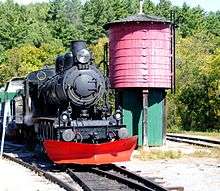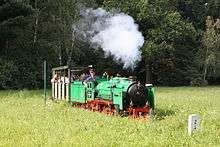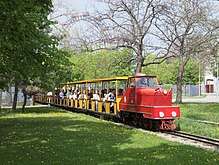Tourist trains
A tourist train is a rail operation intended not as practical transportation (a way to "get in" or "get around") but as a museum-style attraction to see, a tour as an activity to do, or a means to employ historic dining or sleeper train cars as somewhere to eat or sleep for novelty, nostalgia or entertainment purposes.
Tourist trains are distinguished by various factors:
- Deployment of historic or non-standard rolling stock, such as restored steam engines or 1920s Orient Express dining and sleeper cars
- Luxurious and expensive journeys; travel as kings and prime ministers did a century ago, but pay thousands of dollars or euros for a journey which would cost hundreds by air
- Slower journeys for sightseeing or to provide time to serve an elaborate meal on a relatively short-haul itinerary
- On-board novelty entertainment, such as a murder mystery aboard the train
- Circle tours or lines which travel to one tiny, distant town, wait a few hours at most, then bring the same travellers directly back to the point of departure
- Package deals in which a sightseeing train makes a two-day (or longer) journey entirely during daylight hours, with a stay in a tourist hotel for the night bundled in the price
- Package deals in which the train stops in one city for a day or more in the middle of the journey, bundled with a guided walking or bus tour of that intermediate city
- Package deals in which the bundled food, lodging or entertainment are worth more than the transportation component, such as a gourmet dinner on a sightseeing return trip to an adjacent village
- Infrequent or seasonal operation. A train that runs once a year to commemorate a historic event or to view the fall colours is not a serious competitor to a regional commuter train operator.
Historic and museum trains

- See also heritage railways.
Often, historic rolling stock from another era has been painstakingly restored and put back on the rails as a form of living museum exhibit. Steam trains, rolling stock from a bygone era or narrow gauge equipment which cannot run on most of the modern mainline system will often turn up on otherwise little-used track as a means for railroaders to preserve a nostalgic past.
Steam trains in operation include:
- Chehalis-Centralia Railroad, Washington state, USA
- Ffestiniog & Welsh Highland Railways, Gwynedd, Wales
- Gloucestershire Warwickshire Steam Railway, Cheltenham, England
- Little River Railroad, Coldwater, Michigan USA
- Ravenglass and Eskdale Railway, Ravenglass, Cumbria, England
- South Devon Railway follows the River Dart between Buckfastleigh and Totnes, Devon UK
- South Simcoe Railway, Beeton Creek Valley, Ontario, Canada
- The Texas State Railroad, a historic (1881-1921) 25-mile railroad between Rusk and Palestine (Texas) USA with a mix of steam and diesel trains.
- The Puffing Billy, Dandenong Ranges near Melbourne, Australia
Sightseeing and luxury trains
A few trains operate primarily for sightseeing or as nostalgia for an era before mass air travel in which the well-to-do rode the rails in style. Often, these trains are too costly, too slow or serve regions too isolated for these operations to qualify as practical transportation or obtain the subsidies provided to the main national transport network. Aimed at tourists, they usually also offer food, tours and activities.
- The Orient Express has been partially revived as an expensive European luxury/nostalgia train using some original rolling stock. Only one trip annually reaches Istanbul from Paris, though like the original service which was an interconnected network of sleeping cars rather than one single train or route, the same company offers trips to other places as part of their "Orient Express" brand.
- Rocky Mountaineer, British Columbia, Canada. Sightseeing train.
- Royal Canadian Pacific, Calgary and Rocky Mountains (Canada). Luxury train marketed as nostalgia.
- White Pass and Yukon Route, Carcross, Yukon, Canada to Skagway, Alaska USA. Narrow-gauge (3-ft) sightseeing train with some historic rolling stock.
- Tren a las nubes (Train to the clouds) in Salta, Argentina. It's the fifth highest railway in the world, taking you up to an elevation of 4,220 m above sea level.
- In India, several companies operate tours around the country's major sights on board luxury trains. The most famous is probably the sumptuous Maharajas' Express. In addition there are three world heritage listed mountain train routes dating from the colonial era and still running.
- Golden Eagle Luxury Trains operates luxury trains along the Trans-Siberian Railway and other routes in the former Soviet Union and beyond.
- The only motorized way for getting between Ollantaytambo and Aguas Calientes, next to Machu Picchu is the train operated by PeruRail and Inca Rail. The third-highest railway in the world is mostly used by tourists and offers amazing views of the Andes. The company also has other routes in Peru.
- In Mexico, the Ferrocarril Chihuahua al Pacífico (the Copper Canyon train, El Chepe) was built for transportation across 673 km (418 mi), traversing the Copper Canyon in Chihuahua (state).
- While even a regular intercity rail trip in Switzerland often offers scenic views, there is an abundance of special rail experiences from steam-powered trains to the Jungfrau Railway to Europe's highest station and the world heritage listed Rhaetian railway network in the southeast of the country.
- Other than along the east coast and around Perth, train routes across Australia are nowadays geared towards tourists and are operated by Great Southern Rail. Routes include the Ghan from north to south through the Red Centre, the Indian Pacific connecting the Indian and Pacific Oceans and to a lesser extent the Overland from Melbourne to Adelaide.
- Korail offers four special tourist trains, the most luxurious among them being the Haerang rail cruise.
- In South Africa there are the Premier Class, Blue Train and Rovos Rail lines between Pretoria and Cape Town
- The luxurious Eastern and Oriental Express runs from Singapore to Bangkok, passing through Kuala Lumpur, as well as various other smaller cities in Malaysia and Thailand along the way.
Occasionally, a train deployed primarily as practical transportation will attract sightseers if it passes through particularly scenic locations. While these are not tourist trains per se, most of these are listed in the main rail travel articles for the country or destination. There are also a few passenger trains which serve remote points (such as Churchill, Manitoba or Schefferville, Québec in Canada) which have no intercity road access; these are subsidized as part of the main, national system.
Zimbabwe
In Zimbabwe a one-car, 22-seat tram operates as the "Elephant Express" for a two-hour, 70-km journey on the Bulawayo-Victoria Falls rail mainline along the northern boundary of Hwange National Park. The schedules tend to be arbitrarily flexible and very much at the mercy of other through traffic which has priority.
Dinner trains
These runs occupy a similar role to that of a dinner cruise on a tour boat line; they are typically short (an hour to a few hours at most) and operate at relatively slow speeds on otherwise little-used lines. An elaborate dinner served in dining cars or panorama cars often takes up most or all of the time devoted to the trip.
- The Sierra Railroad in Oakdale, California USA operates dinner trains, beer and champagne runs and murder mystery trips using heritage equipment. A few special/excursion trains (such as a "zombie train" for Halloween) operate seasonally.
- The Orford Express between Magog and Sherbrooke, Québec, Canada (a sightseeing train) offers dinner aboard a panorama car on a short-haul trip.
- There is a weekly Tequila Express from Ferrocarril Mexicano station in Guadalajara to the village of Amatitán in Jalisco, where (at the Herradura distillery) the entire tequila production process takes place. The train ride includes mariachi music, along with sample servings of tequila and Corona beer, fruits and cucumber and watermelon sprinkled with paprika.
Attraction and park railways
(see also Grand scale railroads)
Attraction and park railways, are "small" railways, where the railway itself is the destination for a traveller. A large park for example, may have a train which makes a circle tour of a large area of the park, without going beyond the park boundary; in some instances the railway encircles the park (an example being the Disneyland railroad.). A heritage steam train making a circle tour of a pioneer village museum park which could be toured easily on foot is a tourist train.
These are typically, two kinds of attraction railway, miniature railways (also termed 'Grand scale' railroads in the US) and minimum to narrow gauge operations. Scaled versions of full size 'standard' or narrow gauge locos frequently feature. However, both the nominal scale, gauge and extent can vary considerably, from small scale operations in a park or single location up to what are effectively 'miniature mainlines' or minimum gauge 'short' lines. The distinction between a 'Grand scale' model, a 'miniature', and a minimum gauge attraction railway is somewhat blurred, (an example miniature railway, the North Bay Railway in Scarborough, England, having a track gauge wider than some nominally minimum gauge operations!)
Whilst many of these attraction railways are primarily for tourist interest, some of the longer miniature lines also provide practical (although) unusual transport between destinations. In rare instances the modern-day line has been built on the trackbed of much older line (of a larger track gauge), and some of the infrastructure from the earlier era may be extant.
Sometimes longer miniature railways and park railways will employ novelty or panorama-view cars designed for sightseeing.
England
- Romney, Hythe and Dymchurch Railway, New Romney, but runs from here to Dungeness and to Hythe.
- Ravenglass and Eskdale Railway, Ravenglass, one of the earliest miniature lines having been constructed on the track bed of an earlier 19th-century 3-ft gauge line. This charming line runs up to Eskdale from the coast through the countryside of the English Lake District.
- North Bay Railway, Scarborough. This larger (20-in) gauge miniature railway is a worthwhile excursion even if you don't plan on visiting Scarborough's other attractions.
- Wells and Walsingham Light Railway, Wells-next-the-Sea
- Bressingham Steam Experience, Bressingham, Norfolk, This attraction constructed aside the grounds of a now closed plant nursery, boasts 2 miniature lines, and a narrow gauge line. (There's also a short length of standard gauge track used for demonstration purposes.)
- Launceston Steam Railway, Launceston (Cornwall) UK
- Ruislip Lido Railway, Ruislip Lido, London. A minimum-gauge (as opposed to miniature) railway around a created senic lake in NW London.
Scotland
- Kerr's Miniature Railway, West Links Park, Arbroath.
Wales
United States
"Pioneer" railways in Eastern Europe

In the former Eastern bloc, including Poland and East Germany, there are various narrow and very narrow gauge railways that run mostly through a public park and are often historically associated with or still operated by young people or members of the (state-sponsored during Leninist times) "pioneer organization" (e.g. the FDJ or "Jungpioniere" in the GDR). While they do provide some limited transportation value (getting you from one end of a rather large park to the other) they are usually kept for their novelty value and often employ uncommon ways of traction like battery based steam engines. Cities that have them include but are not limited to:
- Berlin/Treptow-Köpenick – Parkeisenbahn Wuhlheide, the longest pioneer railway of former East Germany (7.5 km)
- Dresden – Dresdner Parkeisenbahn within the Großer Garten Baroque gardens
- Chemnitz –
- Cottbus – Parkeisenbahn Cottbus at Branitz Park
- Halle – Parkeisenbahn Peißnitzexpress
- Görlitz – Görlitzer Oldtimer Parkeisenbahn
- Leipzig – Parkeisenbahn Auensee
- Poznan – Maltanka
- Košice
- Budapest – Gyermekvasút (children's railway)
Other

- Stuttgart – Killesbergbahn, Germany's oldest minimum-gauge railway (since 1939)
- Liliputbahn at Vienna's Prater
- Park railways of former horticultural show grounds in Germany, e. g. Cologne (Rheinpark), Dortmund (Westfalenpark), Essen (Grugapark), Karlsruhe (Schlossgarten), Saarbrücken (Franco-German Garden)
Excursion trains
These occupy a similar role to a chartered bus, aircraft or ship. Some are extra trains, outside the primary schedule, which a mainstream rail operator has added to provide transport for a major sporting event or popular tour destination. Others are operated by private, non-railway entities which have paid to use the rails or chartered the train. These were once common in national election campaigns as a means to transport candidates to "whistle stop" appearances in every town on the line, a task now fulfilled most often by a partisan election campaign bus. Some of these trains have been preserved and are either still run for excursions (which may require deep pockets) or are on display in various museums and private collections. While the former use for political campaigning has died a slow death in North America, a 1950s campaign train was brought back in 2009 for a political campaign in Germany to demonstrate an unbroken line of tradition between the party then and now.
A "special" or "extra" train may be added as an excursion run by either a mainline rail operator, a tourist train line or a heritage railway; some operators add an extra train seasonally for fall sightseeing.
Some people also own rail cars that are then coupled to a regular passenger or freight train for an excursion.
Decommissioned rolling stock
Long after an engine or car's travelling life on the rails is over, it may still see use as part of a static exhibit in a museum, park or public venue; a town which uses a former historic rail station as a landmark or travel information office may complement this by restoring a historic engine of the same era for public display beside the old station house. Rail and transportation museums often hold extensive collections of rolling stock. As novelty architecture, a dining car may be installed in a fixed location to house a restaurant; a motel may be constructed using decommissioned sleeper train cars or the distinctive red cabooses which once provided crew quarters at the end of North American freight and goods trains.
Rail and transport museums holding historic equipment or decommissioned rolling stock include:
- Memory Junction, Brighton, Ontario, Canada
- Museum of Transportation, St. Louis, Missouri, USA
- Old Railway Station Museum (Estación del Ferrocarril) in the city of Aguascalientes, México
- Rail Museum of Eastern Ontario, Smiths Falls, Ontario, Canada
See Travel for rail enthusiasts#Museums for additional museum listings.
See also
- Rail travel and heritage railways
- Novelty architecture sometimes employs old trains, cars or rail infrastructure to build "caboose motels" or recycles dining cars as restaurants
- Heritage railway, dinner train and excursion train on Wikipedia.